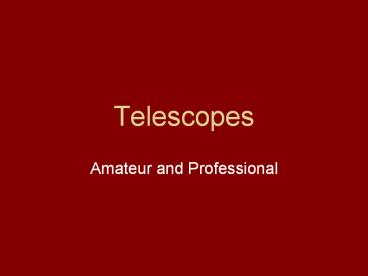Telescopes PowerPoint PPT Presentation
1 / 48
Title: Telescopes
1
Telescopes
- Amateur and Professional
2
Galileo 1609
3
The Moon as a World
4
Jupiter has Moons
5
(No Transcript)
6
Refracting telescopes
7
(No Transcript)
8
Long focus refractors were awkward but suffered
less from chromatic aberration
9
Isaac Newtons reflecting telescope
Mirrors do not have chromatic aberration
10
Reflecting telescope
Objective mirrors instead of lenses
11
Three Powers
- Magnifying
- Resolving
- Light Gathering
12
Magnifying Power
- Ability to make objects appear larger in angular
size - One can change the magnifying power of a
telescope by changing the eyepiece used with it - Mag Power focal length of objective divided by
the focal length of the eyepiece
13
Resolving Power
- Ability to see fine detail
- Depends on the diameter of the objective lens or
mirror
14
Light Gathering Power
- The ability to make faint objects look brighter
- Depends on the area of the objective lens or
mirror - Thus a telescope with an objective lens 2 inches
in diameter has 4 times the light gathering power
of a telescope with a lens 1 inch in diameter
15
Herschel Lord Rosse
16
19th century epoch of the large refractors
17
Refracting telescopes
Lick
Vienna
18
Yerkes Observatory
Largest refracting telescope with a one meter
objective
19
20th century Large Reflectors Come of Age
Mount Wilson Observatory 1.5m (1908) and 2.5m
(1918)
20
Palomar 5-m(entered operation in 1948)
21
4 meter Reflecting telescope
22
Objective Mirror
23
Dome of 4 meter Kitt Peak
24
Keck Telescopes
25
SOAR Telescope
4.1 meter
26
SOAR Telescope -- Cerro Pachon
27
SOAR Observing Room
28
SOAR Image of the planetary nebula NGC 2440
29
MSU Campus Observatory
30
Boller Chivens reflecting telescope with a
24-inch objective mirror
31
More on resolution
- Eagle-eyed Dawes
- The Dawes Limit
- R 4.56/D
- Where
- R resolution in seconds of arc
- D diameter of objective in inches
- More appropriate for visible light and small
telescopes
32
A more general expression for the theoretical
resolving power
- Imagine that star images look like Airy disks
33
Minimum Angle that can be resolved
- R 1.22 x 206,265 l / d
- R resolution in seconds of arc
- l wavelength of light
- d diameter of the objective lens or mirror
- Note that the wavelength of light and the
diameter of the objective should be in the same
units
34
Examples
- For Visible light around 500nm
- Our 24-inch telescope
- R 0.20 seconds
- This may be compared with the Dawes limit of 0.19
seconds - But with large ground-based telescopes it is
difficult to achieve this
35
Astronomical seeing
- Blurring effect of looking through air
- Causes stars to twinkle and planetary detail to
blur - At the SOAR site good seeing means stellar
images better than about 0.7 seconds of arc - In Michigan, good seeing means better than about
3 seconds of arc - Not to be confused with good transparency
36
Bad seeing on this side
Good seeing on this side
37
Electromagnetic Spectrum
38
Radio TelescopesArecibo
39
Very Large Array
40
Radio telescope resolution
- 1m d 100m
- R 2500 seconds 42 minutes!
- Even though radio telescopes are much bigger,
their resolving power is much worse than for
optical telescopes - Interferometric arrays get around this
41
Very Large Array
42
Interferometry
- Size of array 10 km for a VLA
- This becomes the effective d
- Now R becomes 25 secsec for a
- 1-m wavelength
- For VLBI (very long baseline interfeormetry) the
d 10,000km and R 0.025 seconds
43
Observing from space
- No clouds
- Perfect seeing
- Can see wavelengths of light blocked by the
earths atmosphere
44
Hubble Space Telescope
45
(No Transcript)
46
(No Transcript)
47
(No Transcript)
48
Rooftop telescopes

